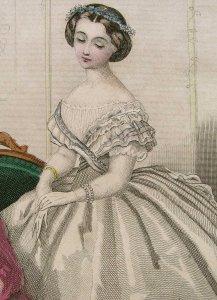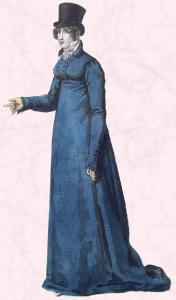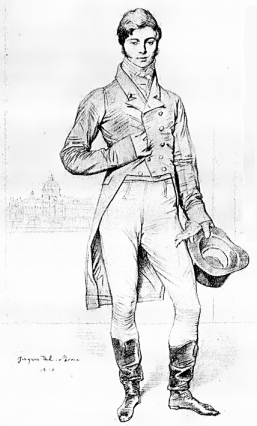A canezou is a women's short, fur-trimmed, sleeveless jacket.
A sleeveless outer garment created from the spencer; later defined as a necktie.
A short chemise with or without sleeves, distinguishing feature was that it was tucked into a belt, where it stopped

Ready - to - Wear
clothes which carry a designer's label but which can be bought ready made off the peg.
Directoire (1795–1799)
The Executive Directory was a body of five Directors that held executive power in France following the Convention and preceding the Consulate. The period of this regime (2 November 1795 until 10 November 1799), commonly known as the Directory (or Directoire) era, constitutes the second to last stage of the French Revolution.
It was during the second half of the 1790s that fashionable women in France began to adopt a thoroughgoing Classical style, based on an idealized version of ancient Greek and Roman dress, with narrow clinging skirts. Some of the extreme Parisian versions of the neo-classical style (such as narrow straps which bared the shoulders, and diaphanous gowns without sufficient stays, petticoats, or shifts worn beneath) were not widely adopted elsewhere, but many features of the late-1790s neo-classical style were broadly influential, surviving in successively modified forms in European fashions over the next two decades.
White was considered the most suitable color for neo-classical clothing (accessories were often in contrasting colors). Short trains trailing behind were common in dresses of the late 1790s.
Directoire and Empire (1795-1815)
This period, referred to as Regency style in England, followed the French and American revolutions. It saw a drastic shift in dress for both men and women, though for women this change would be short lived. Classical Greek and Roman images were evoked to justify the democratic revolutions of this period. This resulted in the adoption of a classically inspired silhouette for women, who was long, narrow, uncorsetted, and high waisted. Initially the colour of choice was white, and the fabrics soft cottons, often virtually transparent. Shawls and long gloves were introduced to cover bare shoulders and arms; shawls would remain in fashion until the advent of the bustle in the 1880's. Hair might be cut short, and turbans and caps were worn.
After 1805, as society began to return to a more sedate, conservative mode, and as the aristocracy returned to France, dress gradually became less semi-fitted and more tailored. Bodices became more fitted; more surface decoration was used, as well as heavier fabrics and more modest long sleeves. As it turned out, the revolutions had opened up new opportunities for men; but for women, life would continue much as it had before. Therefore the dress forms would also return to those that had been in use for centuries.

Carrickmacross Lace
Muslin lace with applique motifs, originating on the town of carrickmacross in the county monaghan, Ireland. This fine, gauzy lace was first made in the 1820's and its popularity endures for one hundred years.
THE REDINGOTE
Redingotes were used alongside mantles and cloaks for everyday wear often because they were practical, utilitarian, unfussy and unnoticeable compared to more ostentatious lavishly trimmed clothes. They often used for riding.
From the mid 1700s British village woman mostly wore hooded cloaks for outdoor wear. Riding dress used tailoring in coat making. Even by 1800 few women wore the highly tailored topcoats known as the redingote. At the turn of 1800 the art of tailoring was only just developing into a fitted, contoured, make the best of the body style we recognize today.
Redingotes or the ‘riding dress’ towards the end of the Victorian era itself became a fashion garment in its own right and was usually referred to as a redingote, whereas riding dress had changed to a shorter jacket and side saddle skirt or riding breeches. Forest green, black, and red were all colors used for riding dress.
Early redingotes appeared in the late 1780s and were versatile enveloping full-length overcoats. The English redingote was made of good woollen cloth and was generally lightweight, but it also had shoulder capes and buttoned across the chest. It was popular in many forms through the 19th century and basically began life as an outdoor riding coat for inclement weather.
The caped redingote was a very suitable garment for wearing in rainy weather because the layers of capes provide extra shoulder protection. A similar technique of using a back half yoke sometimes just at the back, but often also on the front is still added to raincoats today and provides an extra fabric layer at the front chest and at the back shoulder blades level. Such extra layering helps prevent the wearer from feeling soaked in a rain downpour.
In England where side saddle riding for women remained popular for many years full skirted redingotes with excess fabric skirts were worn to elegantly cover the legs from view. They often also covered trousers hidden well beneath the layers, but perfect if the lady fell of her horse.
The riding dress of the 19th century followed the huge gigot and leg of mutton sleeve styles of both the 1830s and the mid 1890s. In the latter era skirts though became a bit more practical with fullness, but without trails of fabric. Ironically the fashion for tailor made suits actually followed the severe lines of these tailored riding habits.
Women's redingote
The first form of the redingote was in the 1700s, when it was used for travel on horseback. This coat was a bulky, utilitarian garment. It would begin to evolve into a fashionable accessory in the last two decades of the 18th century, when women began wearing a perfectly-tailored style of the redingote, which was inspired by men's fashion of the time. Italian fashion also picked it up (the redingotte), adapting it for more formal occasions.
The redingote à la Hussar was trimmed with parallel rows of horizontal braid in the fashion of Hussars' uniforms.
The style continued to evolve through the late 19th century, until it took a form similar to today's redingote. The newer form is marked by a close fit at the chest and waist, a belt, and a flare toward the hem.
Men's redingote
The men's redingote was an 18th century or early 19th century long coat or greatcoat, derived from the country garment with a wide, flat collar called a frock In French, redingote is the usual term for a fitted frock coat. The form a men's redingote took could be of the tightly fitting frock coat style, or the more voluminous, loose "great coat" style, replete with overlapping capes or collars, such as a "garrick" redingote.


The

English Dandy
a person who is concerned with his dress and appearence.
britches are longer than the knee and tight fitting.
short jacket to the front with a military influence with a long waistcoat underneath



Banyan
http://en.wikipedia.org/wiki/Banyan_(clothing)
Glossary
No comments:
Post a Comment